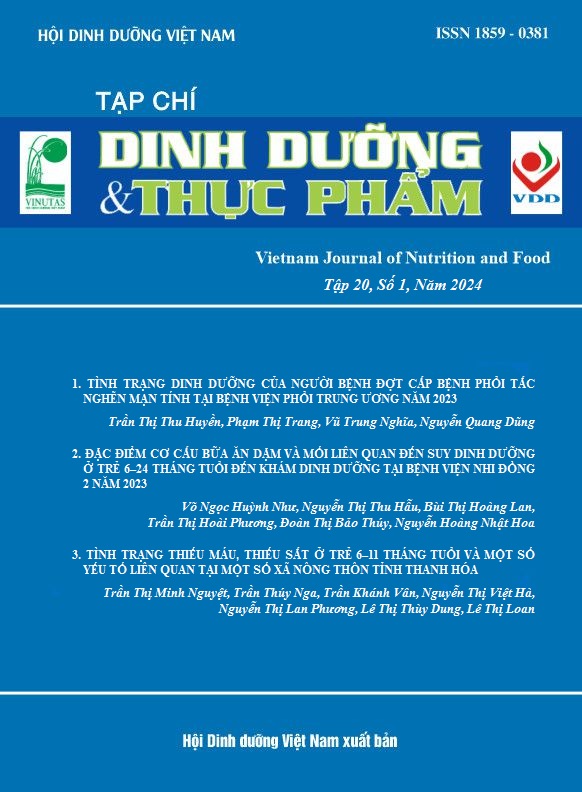STUDYING THE PRODUCTION OF RICE PROTEIN HYDROLYSATE FROM RICE MILK RESIDUE USING COMMERCIAL PROTEASE
Main Article Content
Abstract
Aims: To determine the optimal parameters for the process of extracting protein from rice milk residue, which has starch and carbohydrates removed, using commercial protease enzymes.
Methods: The study was conducted based on the selection of nine types of commercial enzymes from Amano-Japan, and then the optimization of enzymatic conditions was carried out to extract protein from rice milk residue using the Response Surface Methodology (RSM) with an I-optimal model. The product of the research was analyzed using SDS-PAGE to assess the protein composition.
Results: The enzyme "Protein Amano" SD-AY10 from Amano-Japan was chosen because it was the best at extracting proteins and had the highest degree of hydrolysis of all the enzymes that were tested. The optimization process using SD-AY10 achieved a protein extraction yield of 90.1% from rice milk residue under the conditions of 1.2% enzyme concentration, 2.5% NH4SO4 concentration, pH 8 temperature, 60°C time, and 120 minutes of hydrolysis. This led to an extraction yield of 90.1%, close to the calculated maximum of 91.37%, and the protein content in the hydrolysate reached 19.1% dry substance. The SDS-PAGE analysis showed that the product had peptides with molecular weights below one hundred kDa. This means that it has high nutritional and functional quality and can be used to make food, cosmetics, and medicines for people to eat.
Conclusion: The result contributes to the diversification of products derived from agricultural by-products, particularly those from rice, supporting the development of sustainable food processing and production industries.
Keywords
Rice protein hydrolysate, rice milk residue, protease, protin “Amano” SD-AY10, response surface methodology
Article Details
References
2. Roy T, et al. Rice protein: Emerging insights of extraction, structural characteristics, functionality, and application in the food industry. Journal of Food Composition and Analysis. 2023:105581.
3. Zheng L, et al. Reconstituted rice protein: The raw materials, techniques and challenges. Trends in Food Science & Technology, 2023.
4. Charoen R, Tipkanon S, and Savedboworn W, Production of rice bran protein hydrolysates from traditional Thai rice bran (Plai-Ngahm-Prachinburi). International Food Research Journal. 2017;24:2304-2311.
5. Hamada JS. Use of proteases to enhance solubilization of rice bran proteins. Journal of Food Biochemistry, 1999;23:307-321.
6. Hanmoungjai P, Pyle DL, and Niranjan K. Enzyme-assisted water extraction of oil and protein from rice bran. Journal of Chemical Technology & Biotechnology: International Research in Process, Environmental & Clean Technology. 2002;77(7):771-776.
7. Morita T and Kiriyama S. Mass production method for rice protein isolate and nutritional evaluation. Journal of food science. 1993; 58(6):1393-1396.
8. Tang S, Hettiarachchy NS, and Shellhammer TH. Protein extraction from heat-stabilized defatted rice bran. 1. Physical processing and enzyme treatments. Journal of Agricultural and Food Chemistry. 2002;50(25):7444-7448.
9. Vo HT, et al, Optimization of Protein Hydrolysate Production from Defatted Rice Bran and Refining Process. 2017.
10. Lê Viết Hùng and H.Q. Tuấn, Nghiên cứu thu hồi protein trong bã gạo của quá trình sản xuất sữa gạo tại nhà máy Lavina food Công ty cổ phần mía đường Lam Sơn, in Viện Công nghệ sinh học và công nghệ thực phẩm. 2022, Đại học Bách Khoa Hà Nội: Đại học Bách Khoa Hà Nội.
11. Jiang Y, et al. Effects of salting-in/out-assisted extractions on structural, physicochemical and functional properties of Tenebrio molitor larvae protein isolates. Food chemistry. 2021;338:128158.
12. Pham T, et al. Effects of pH and Salt Concentration on Functional Properties of Pumpkin Seed Protein Fractions. Journal of Food Processing and Preservation. 2017;41.
13. Nielsen, P.M., D. Petersen, and C. Dambmann, Improved Method for Determining Food Protein Degree of Hydrolysis. Journal of Food Science. 2001; 66(5):642-646.
14. Jones CG, Daniel Hare J, and Compton SJ. Measuring plant protein with the Bradford assay : 1. Evaluation and standard method. J Chem Ecol. 1989;15(3):979-992.
15. Amagliani L, et al. Composition and protein profile analysis of rice protein ingredients. Journal of Food Composition and Analysis. 2017;59:18-26.
16. Gerzhova A, et al. Study of total dry matter and protein extraction from canola meal as affected by the pH, salt addition and use of zeta-potential/turbidimetry analysis to optimize the extraction conditions. Food chemistry. 2016;201:243-252.
17. Zhao Q, et al. Enzymatic hydrolysis of rice dreg protein: effects of enzyme type on the functional properties and antioxidant activities of recovered proteins. Food chemistry. 2012;134 3:1360-1367.
18. Charoen R, Tipkanon S, and Savedboworn W. Production of rice bran protein hydrolysates from traditional Thai rice bran (Plai-Ngahm-Prachinburi ). 2017.


